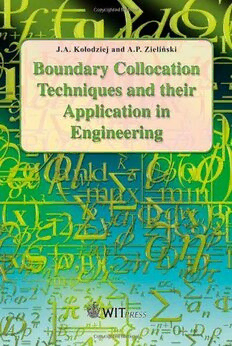Download Boundary Collocation Techniques and Their Application in Engineering PDF Free - Full Version
Download Boundary Collocation Techniques and Their Application in Engineering by Jan Adam Kolodziej, Andrzej Piotr Zielinski in PDF format completely FREE. No registration required, no payment needed. Get instant access to this valuable resource on PDFdrive.to!
About Boundary Collocation Techniques and Their Application in Engineering
Methods of mathematical modeling applied in contemporary computationalmechanics can be either purely numerical or analytical-numerical procedures. Purely analytical solutions are losing their popularity because of strong limitations connected with the simple regions and the mostly linear equations to which they can be applied. The fundamental monographs (for example, those on elastic solids, fluid mechanics or heat exchange) are always popular and often quoted, but as sources of comparative benchmarks confirming correctness and accuracy of computer solutions.This volume is divided into two parts. The first part provides a generalpresentation of the boundary collocation approach and its numerous variants. In the second part the method is applied to many different engineering problems, showing its properties, accuracy and convergence. Both evident advantages and also limitations of the approach are clearly presented. The observations are based mainly on investigations, carried out in the last two decades, by the authors and their co-operators. The monograph includes figures and tables that present results of numerical examples. Over 1000 papers and monographs concerning theapproach are quoted. They are listed separately in each chapter,which makes the literature survey easier to use.The book will be useful to engineers and scientific workers who are solving problems of solid and fluid mechanics with the help of boundary methods.
Detailed Information
| Author: | Jan Adam Kolodziej, Andrzej Piotr Zielinski |
|---|---|
| Publication Year: | 2009 |
| ISBN: | 9781845643942 |
| Pages: | 337 |
| Language: | English |
| File Size: | 5.811 |
| Format: | |
| Price: | FREE |
Safe & Secure Download - No registration required
Why Choose PDFdrive for Your Free Boundary Collocation Techniques and Their Application in Engineering Download?
- 100% Free: No hidden fees or subscriptions required for one book every day.
- No Registration: Immediate access is available without creating accounts for one book every day.
- Safe and Secure: Clean downloads without malware or viruses
- Multiple Formats: PDF, MOBI, Mpub,... optimized for all devices
- Educational Resource: Supporting knowledge sharing and learning
Frequently Asked Questions
Is it really free to download Boundary Collocation Techniques and Their Application in Engineering PDF?
Yes, on https://PDFdrive.to you can download Boundary Collocation Techniques and Their Application in Engineering by Jan Adam Kolodziej, Andrzej Piotr Zielinski completely free. We don't require any payment, subscription, or registration to access this PDF file. For 3 books every day.
How can I read Boundary Collocation Techniques and Their Application in Engineering on my mobile device?
After downloading Boundary Collocation Techniques and Their Application in Engineering PDF, you can open it with any PDF reader app on your phone or tablet. We recommend using Adobe Acrobat Reader, Apple Books, or Google Play Books for the best reading experience.
Is this the full version of Boundary Collocation Techniques and Their Application in Engineering?
Yes, this is the complete PDF version of Boundary Collocation Techniques and Their Application in Engineering by Jan Adam Kolodziej, Andrzej Piotr Zielinski. You will be able to read the entire content as in the printed version without missing any pages.
Is it legal to download Boundary Collocation Techniques and Their Application in Engineering PDF for free?
https://PDFdrive.to provides links to free educational resources available online. We do not store any files on our servers. Please be aware of copyright laws in your country before downloading.
The materials shared are intended for research, educational, and personal use in accordance with fair use principles.

